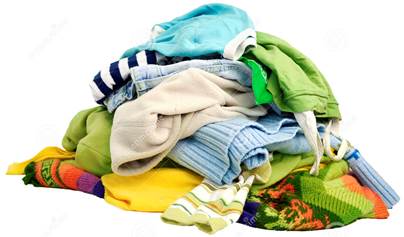
Clothing

Did you know a fleece jacket can shed as many as 250,000 fibres per wash!
Polyester/fleece clothes do not biodegrade and create a microplastics problem in our environment.
This article describes microplastic contamination found in extremely high levels across the Bay of Plenty moana. Tiny plastic particles have been found in shellfish and sediment.
"More than 220,000 tonnes of textiles end up in our landfills annually - that's about 44kg of waste per person every year." So says this Newshub article.
"Every year here in New Zealand, we import over 380,000 tonnes of textile products, with well over half that amount ending up in landfill. In addition to greenhouse gas emissions from decomposing textiles, the synthetic and blended clothing which now makes up the bulk of what the world wears generates huge amounts of plastic pollution. A 2019 study found that around 87% of the microplastics polluting Auckland’s waterways came from synthetic textiles." This from The Spinoff.
Clothing placed in recycle bins are sorted and separated into good quality clothing and shoes which can be reused or worn. Damaged clothing is further sorted into grades to make industrial wiping clothes, blankets, furniture blankets, mattresses, car insulation and furniture padding.
"Usedfully is on a mission to create a viable textile recycling solution in New Zealand to help divert 220,000 tonnes of textiles from landfill each year."
What happens to waste textiles? Read about this initiative NZ Textile Reuse Programme.
You can reduce the need to purchase new clothing by buying good quality items that will last or can be easily repaired. Rather than buying new, see if clothing items can be repaired. Check out the Clothing - Alterations and Repair agents listed in the Yellow Pages.
Buy natural-fibre clothing wherever possible as this will reduce non-biodegradable waste.
Sew your own clothes and beat 'fast fashion'! Check out who is offering sewing classes in town.
Reduce the volume of microfibres polluting our oceans by washing your clothes less. (Yes, really!)
Tips to reduce microplastic waste from clothing:
- Use your washing machine’s eco- or short-wash cycle. The longer clothes are washed, the more opportunity microplastics get to be released.
- Wash similar textiles together. Harder fabrics, such as denim, can rub up against softer ones in the wash, which can release fibres.
- Don’t wash your clothes as often. If you can, wash stains by hand.
Wash bags specifically designed to reduce microplastics waste to waterways can be purchased in New Zealand.
Donate your pre-loved clothing to secondhand/charity shops, and do your own shopping there too!
Share clothing with friends, attend clothes-swap events.
If you've got the space, store favourite clothing/textile articles - as fashion trends do come round again.
Worn or damaged clothing and sheets can be used around the house for dusters or cleaning cloths. Old clothing can be reused to make covers for quilts and cushions. Cut worn sheets/bedding and re-sew to get more wear out of them.
Consider remodelling/making clothes for good causes like Dress a Girl Around the World.
SaveMart has recycle bins onsite at the Whanganui Resource Recovery Centre, shopping centres and other locations around our region.
Does anyone want to set up a fabBRICK textile recycling operation here?!
Please keep polyester, nylon, microfibre (non-biodegradable) textiles from landfill as long as possible.